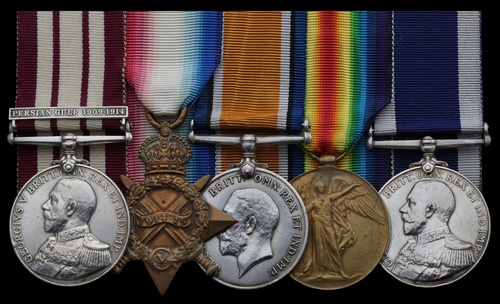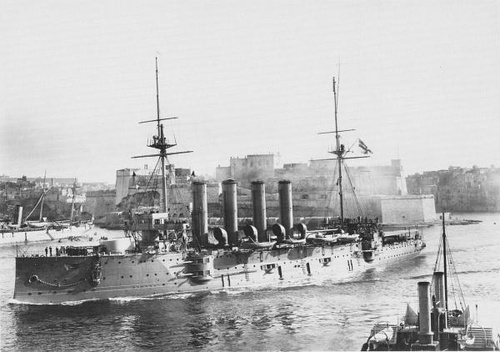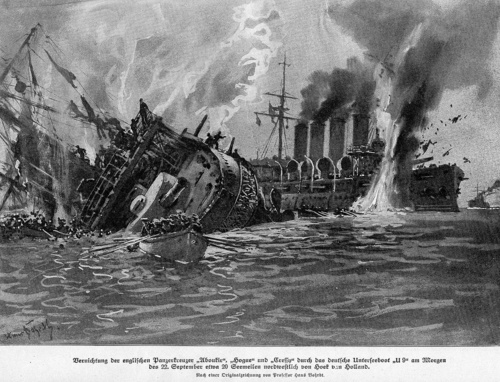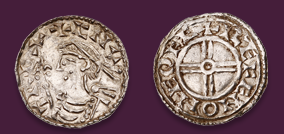Auction: 22103 - Orders, Decorations and Medals VII - e-Auction
Lot: 377
(x) Five: Supply Officer A. Rickard, Royal Navy, whose long service was almost ended on 22 September 1914 with the sinking of the Aboukir
Later serving with H.M.S. Ajax at the Odessa evacuations and during the Great Smyrna Fire and transporting the deposed Mehmed VI to Mecca
Naval General Service Medal 1915-62, 1 clasp, Persian Gulf 1909-1914 (344202. A. Rickard, Ship. Std. H.M.S. Highflyer.); 1914-15 Star (344202. A. Rickard. S. Std., R.N.); British War and Victory Medals (344202 A. Rickard. V.C.P.O. R.N.); Royal Naval L.S. & G.C., G.V.R. (344202. Allan Rickard, Sh. Stwd. H.M.S. Wallington.), pitting, contact marks, nearly very fine (5)
Allan Rickard was born at New Brompton, Kent on 6 December 1882. Enlisting on 1 May 1901 with the rank of Ship's Steward's Assistant he worked on a number of vessels being promoted Ships Steward while aboard H.M.S. Bedford on 15 April 1908. After a period of service ashore Rickard was posted to H.M.S. Highflyer, a protected cruiser serving as Flagship of the East Indies Station. While here he was involved in the suppression of pirates and slavers in the Persian Gulf.
Aboukir - 22nd September 1914
Leaving Highflyer for Cressy on 13 August 1913 Rickard did not stay long aboard her but instead transferred- somewhat ironically- to Aboukir on 26 July 1914. This Cressy-class armoured cruiser was with the 7th Cruiser Squadron on 22 September 1914 without their destroyer escort who had been forced back to port by poor weather.
Unfortunately at this moment of vulnerability they were spotted by U-9 commanded by Kapitänleutnant Otto Weddigen who manoeuvred his vessel for an ambush. In the early hours of the morning the first torpedo struck, catching Aboukir on the starboard side and flooding her engine room.
So sudden was the ambush that the other cruisers assumed she had struck a mine and moved to help their stricken companion. This was a fatal error which opened both up to attack, Hogue was the next hit, struck by two torpedoes even as her gunners caught sight of their assailant and opened fire in return.
This return fire caused U-9 to dive and it after an attempt to ram her evasive tormentor Cressy, the last of the three sister ships, moved to pick up survivors. At this moment U-9 made her final climactic appearance, firing two more torpedoes at the sole surviving cruiser. The affect, tragically, was to flip the Cressy upside-down causing horrific casualties including the Captain Robert Johnston.
The destruction of the Squadron had taken less than one hour. Rickard was lucky, he managed to survive the loss of Aboukir though not perhaps as lucky as Midshipman Wenman Wykeham-Musgrave who famously survived the sinking of all three vessels.
South Russia
Rickard returned ashore and remained there for some time before joining H.M.S. Wallington an outdated Pearl-Class cruiser serving as a Guard Ship and later Base Ship at Chatham. During her time at Chatham Wallington was overflown by Zeppelins and even fired upon. Leaving on 16 January 1917 Rickard's next and final posting was the King George V-class dreadnought Ajax. He joined her on 30 December 1919 and was still with her several months later when she set out for Odessa.
The White Russian Army had been driven back to the Crimea and- wrong footed by a Bolshevik uprising- was preparing to evacuate by the time of Ajax's arrival. That evacuation was a hurried and by all accounts botched affair but a number of White Russian troops and leaders were successfully taken off. Many survivors were forced to withdraw overland towards Romania in the depths of winter and under heavy attack by Bolshevik cavalry their losses were terrible.
Standing off from Odessa and sailing for Constantinople Ajax dropped off her passengers and returned to Russia. This time scouting the Bolshevik advances in the Caucasus, while undertaking this task they bombarded the Red positions at Sochi. Later aiding the evacuation of the last White Russian troops in Georgia she left Russia at the end of Summer 1920.
Transporting Mehmed VI
Joining the Mediterranean Fleet after leaving Russia Ajax, with Rickard aboard, sailed for Smyrna as the Chanak Crisis came to a head. The British Fleet remained in the harbour while the city burned and it was not until negations brought an end to the Crisis that they moved on. However Ajax was not done with Turkey and she returned in 1922 to carry Mehmed VI to Mecca. Rickard was reclassified Stocker Petty Officer on 10 November 1922 and then promoted Supply Officer on 23 July 1923 he left Ajax on 25 July.
Subject to 5% tax on Hammer Price in addition to 20% VAT on Buyer’s Premium.
Sold for
£400
Starting price
£170









